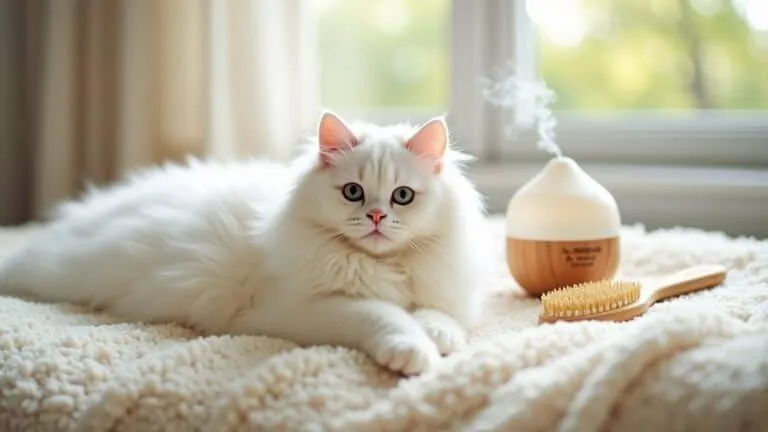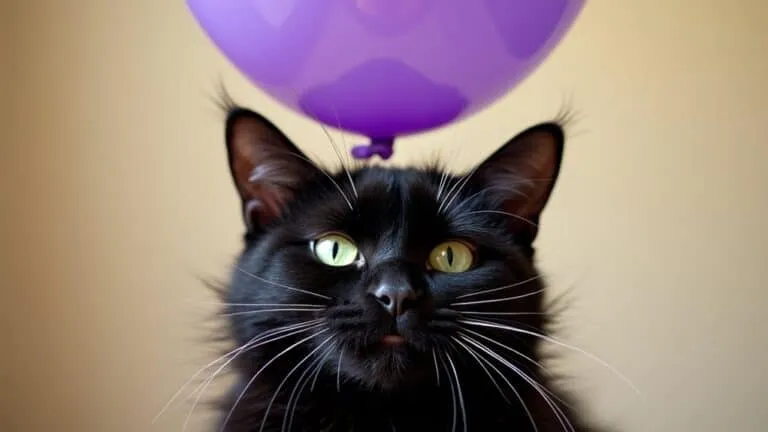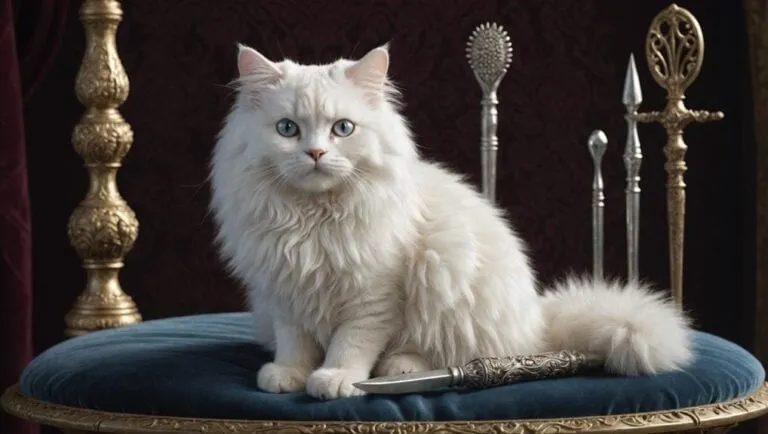The Best Fluffy Pancakes recipe you will fall in love with. Full of tips and tricks to help you make the best pancakes.
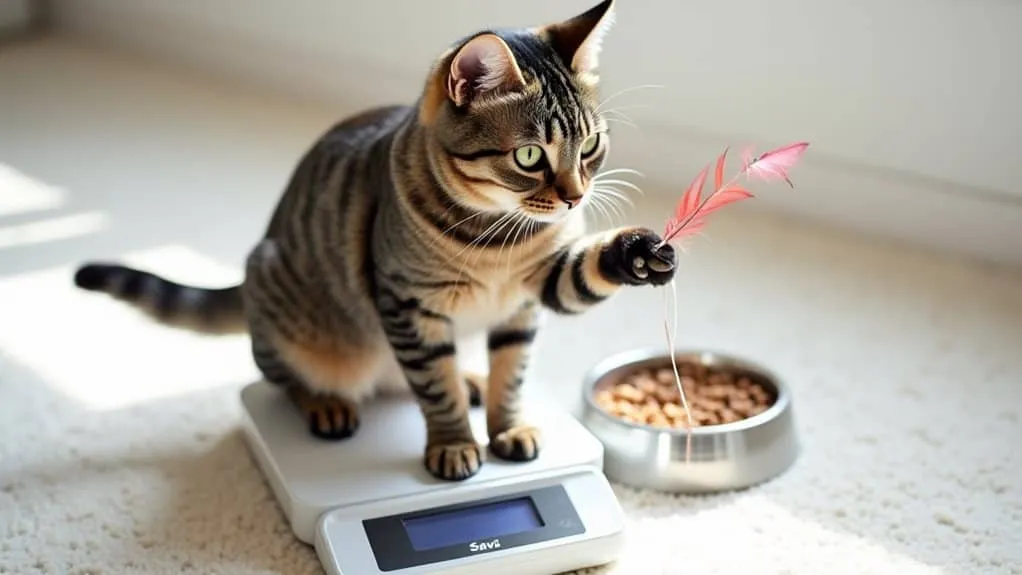
If you've noticed your indoor cat getting a bit rounder during the winter months, you're not alone. Just like humans who crave comfort food when it's cold outside, your feline friend's ancient survival instincts kick in, telling them to pack on extra pounds for the lean times ahead. While this made perfect sense for their wild ancestors, your pampered house cat doesn't need these extra reserves. Let's explore how you can keep your furry companion fit and healthy during the winter season.
Understanding Winter Weight Challenges for Indoor Cats
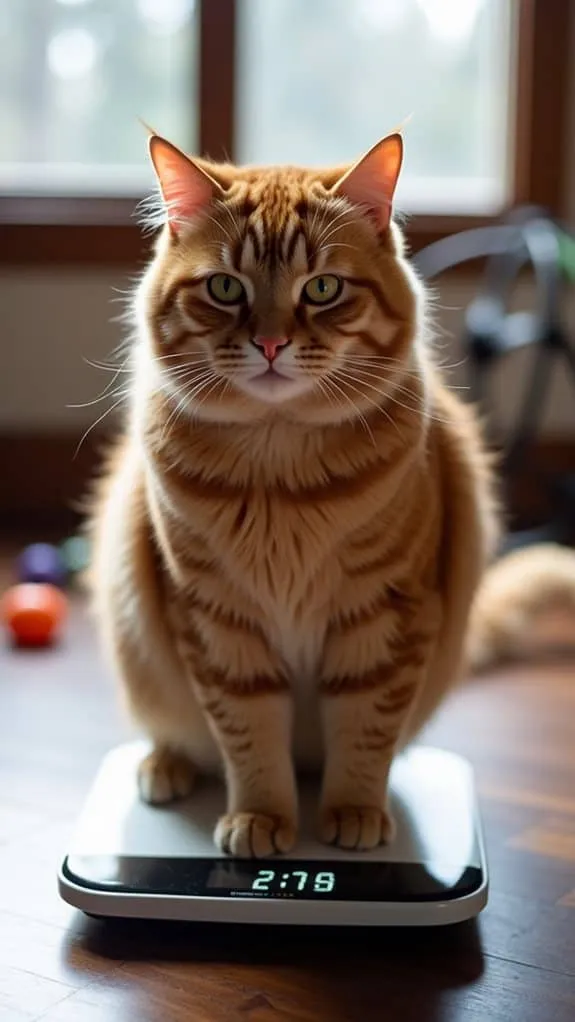
While winter brings cozy moments for you and your feline friend, it's also a challenging season when it comes to maintaining your cat's healthy weight. Your indoor cat's natural instincts tell them to store energy during colder months, which can complicate weight management efforts.
You'll notice changes in feline behavior as shorter days and chilly temperatures lead to less activity. Just like humans, cats tend to become more sedentary during winter months, and some may eat more to stay warm. Our feline companions have inherited their evolutionary food drive from their ancestors who needed extra fat stores to survive harsh winters. In fact, cats typically require 15% more food during the winter season to meet their increased energy needs. Additionally, it is important to ensure they have adequate indoor enrichment to promote physical activity and mental stimulation during this time.
If you're caring for an indoor cat, you'll need to pay extra attention to their activity levels and eating habits. Your furry friend's genetic makeup and breed characteristics can also influence their winter weight gain tendencies, making it essential to develop a customized approach to their care.
Essential Nutrition Tips for Cold Weather
Since your cat's nutritional needs shift during colder months, you'll want to make strategic adjustments to their diet. Focus on protein-rich foods like lean meats and fish to help maintain their energy levels and body heat. Additionally, ensuring your cat consumes enough fresh, flowing water promotes hydration and overall health, especially during winter when they may drink less.
Consider adding nutritional supplements, especially fish oil, to support their coat health during the dry winter season. Setting up elevated feeding areas can protect them from cold drafts during mealtimes. Regularly monitoring your cat for any behavioral changes or lethargy can help identify potential nutrition-related issues early.
Don't forget about winter hydration – your furry friend might drink less when it's cold, so try incorporating wet food into their diet. You can also warm their water slightly to make it more appealing.
For outdoor cats, you'll need to increase their caloric intake with high-quality proteins and healthy fats. Keep an eye on portion sizes, though – even active outdoor cats can pack on extra pounds if overfed.
Think of it as finding the perfect balance between warmth and wellness.
Smart Portion Control Strategies
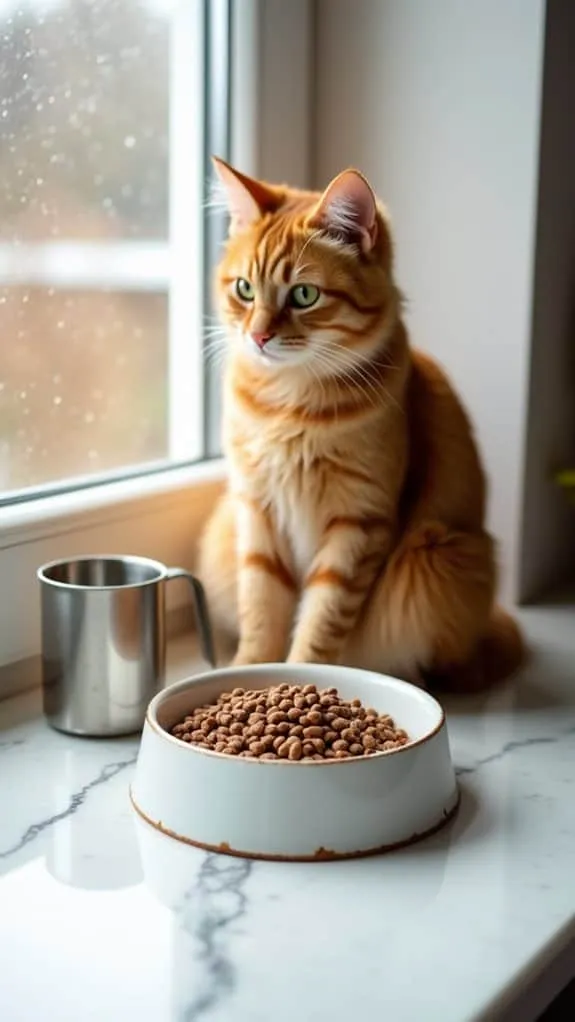
You'll see better results with your cat's weight management when you carefully measure each meal using precise portions rather than eyeballing the amount of food.
It's crucial to match your cat's food intake with their activity level, making adjustments based on whether they're a couch potato or an energetic explorer. Cats should also have adequate opportunities to relieve themselves in a stress-free environment, which can be achieved by providing multiple litter boxes. Consulting with a veterinary professional is essential for determining the right portion sizes for your specific cat.
Using measuring cups or a kitchen scale to portion out meals will help you stay consistent with feeding amounts, ensuring you're not accidentally overfeeding your furry friend. A veterinary weight-loss food can help increase your cat's metabolism while preserving lean muscle mass.
Measure Meals With Precision
Three essential strategies form the foundation of smart portion control for your feline friend.
First, you'll want to master meal measuring by using proper tools to portion out each serving accurately. Regular grooming promotes better circulation and overall skin health, which can be beneficial for your cat's wellbeing during their weight management journey.
Second, divide your cat's daily food allowance into two meals, spaced 8-12 hours apart for ideal digestion and satisfaction.
Using a kitchen gram scale helps ensure exact measurements for weight control success.
When it comes to portion precision, you're not just guessing – you're taking control of your cat's health.
Set a specific feeding time, like 30 minutes, and remove any uneaten food afterward.
Evaluating your cat's body shape by looking at their silhouette and feeling their belly helps determine if your portion control is working.
Try using food puzzles or feeding stations to make mealtime more engaging while maintaining proper portions.
Remember to keep treats to less than 10% of daily calories, and you'll be well on your way to maintaining your cat's healthy weight through smart portion management.
Balance Activity With Intake
Balancing your cat's food intake with physical activity creates a winning formula for weight management.
When you monitor portions while encouraging movement, you'll help your feline friend maintain a healthy weight. Even small portions can contribute to obesity if not carefully measured. Different cats may require feeding in shifts to prevent food aggression and ensure proper portions. Transform mealtime into an engaging experience by incorporating activity balance throughout your home. Regular play sessions not only encourage exercise but also enhance the bond between you and your cat.
Try these creative ways to combine feeding with exercise:
- Place food puzzles in different locations to encourage exploration and mental stimulation
- Toss kibbles down hallways to spark your cat's natural hunting instincts
- Set up multiple feeding stations at varying heights to promote climbing
- Use interactive toys filled with small portions to extend mealtime fun
Indoor Exercise Ideas to Beat Winter Blues
You'll find that interactive wand play gives your cat an exciting way to pounce and chase, mimicking their natural hunting instincts even when stuck indoors.
Installing cat trees near windows creates the perfect spot for your feline friend to climb, scratch, and watch the winter world outside while staying active.
Try hiding small portions of your cat's regular food around the house or in puzzle feeders to encourage movement and mental stimulation during those chilly days when outdoor adventures aren't possible. Engaging in interactive playtime fosters stronger human-animal bonds and keeps your kitty mentally stimulated.
Interactive Wand Play Time
While winter weather keeps everyone indoors, interactive wand play offers an exciting way to keep your cat active and mentally stimulated during those long, cold months. Your wand selection and play techniques can make all the difference in creating engaging play sessions that'll have your feline friend purring with joy.
To make the most of your interactive playtime, consider these proven strategies:
- Schedule short, frequent sessions during dawn or dusk when your cat's naturally most active.
- Rotate between different wand toys with varying textures and materials.
- Mimic natural prey movements by making the toy dart and hide.
- Always end play sessions with a physical toy as a reward.
Incorporating interactive cat toys can further enhance the play experience, providing additional stimulation and engagement opportunities.
You'll notice your cat's energy levels improve, and you'll strengthen your bond while helping them maintain a healthy weight through winter.
Cat Trees For Movement
Interactive play sessions work wonders for your cat's activity levels, but adding a cat tree to your indoor space creates a complete fitness zone that's available 24/7.
The cat tree benefits are truly remarkable – your feline friend will have a dedicated spot for climbing exercises that strengthen muscles and maintain a healthy weight.
When you're choosing the perfect cat tree for your home, look for one with multiple levels, sturdy scratching posts, and cozy hideaways.
You'll notice positive changes in your cat's behavior as they explore their new vertical territory. Not only will they get more exercise, but they'll also feel more secure and mentally stimulated.
Plus, if you've got multiple cats, a cat tree helps them share space harmoniously while staying active – it's like having a kitty gym right in your living room! Additionally, incorporating multi-level structures in your design ensures enhanced exploration and climbing opportunities for your cat.
Food-Based Activity Games
Turning mealtime into playtime creates one of the most effective ways to keep indoor cats active and engaged during the winter months.
You'll find that incorporating food puzzles and treat hiding games can transform your cat's daily routine into an exciting adventure that mimics their natural hunting instincts.
Here are some fun food-based activities you can try with your feline friend:
- Create a DIY treat maze using cardboard boxes and tubes
- Hide small portions of kibble throughout different rooms
- Use a puzzle feeder to make mealtime more challenging
- Place treats in muffin tins covered with toys
Additionally, these activities reinforce interactive play as essential for keeping your cat happy and engaged.
These enriching activities won't just help manage your cat's weight – they'll also provide mental stimulation and satisfaction.
Your cat will love working for their food, just as they'd in nature, keeping them both physically active and mentally sharp throughout the winter season.
Tracking Your Cat's Winter Weight
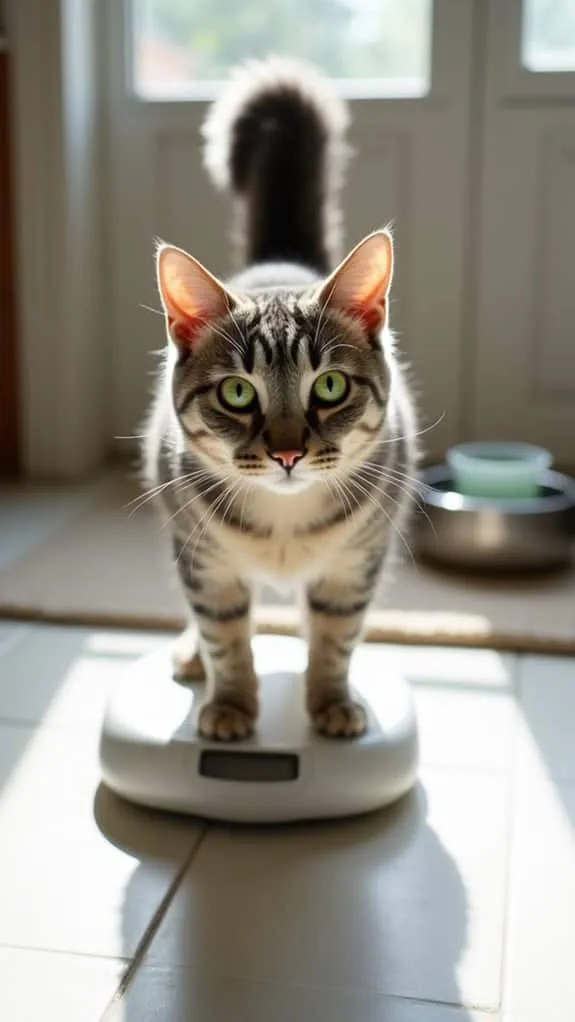
As winter settles in, your feline friend's weight might start creeping up without you noticing. Understanding normal weight fluctuations and establishing reliable monitoring methods will help you keep your cat healthy during the colder months.
You'll want to track any changes that exceed a pound, as these could signal health concerns that need veterinary attention.
Don't let your cat's fluffier winter coat fool you – while they might look chubbier, it's important to feel for actual weight changes beneath that seasonal fur. Regular weigh-ins can provide valuable insights into the cat's well-being and help you make informed decisions about their care.
Set up a regular weigh-in routine, perhaps monthly, and keep a simple log of the results. If you're noticing steady weight gain, you can adjust portion sizes and increase playtime to help maintain a healthy weight.
Healthy Treats and Smart Snacking
When it comes to keeping your cat happy and healthy, choosing the right treats plays a significant role in their overall fitness journey. Understanding healthy treat benefits and implementing smart snacking tips can make a huge difference in your cat's well-being.
You'll want to focus on high-protein, low-carb options while avoiding artificial ingredients and table scraps.
Here are essential tips for treating your feline friend:
- Choose freeze-dried meat treats that are rich in protein
- Measure portions carefully, limiting treats to 10-15 per day
- Select treats with simple, natural ingredients
- Use treats for training and bonding, not just free feeding
Seasonal Diet Adjustments That Work

Just like humans adjust their wardrobes with the seasons, cats need dietary changes to stay healthy year-round. When winter arrives, you'll want to increase your cat's caloric intake by 10-15% to help them maintain body heat and energy levels.
Making smart seasonal food choices is key to keeping your furry friend fit and happy. Focus on nutrient density by selecting high-quality proteins and incorporating warming foods into their diet. You can warm up their wet food slightly or add nutrient-rich broths (without onion or garlic) to their meals.
Don't forget to monitor their weight regularly – while they need extra calories in winter, you'll want to prevent excessive weight gain. Consider adding superfoods like pumpkin or salmon to boost their nutrition, and always keep fresh water available to maintain proper hydration.
Creating an Active Winter Routine
Indoor winter months don't have to mean a sedentary lifestyle for your feline friend. You can create an engaging indoor exercise routine that'll keep your cat active and entertained throughout the cold season.
Start by creating obstacle courses using everyday items, and consider investing in cat wheels for continuous movement opportunities.
Here's what you can do to keep your cat moving this winter:
- Set up a dedicated play area with climbing trees and window perches
- Introduce puzzle feeders to combine mealtime with exercise
- Schedule daily interactive play sessions using laser pointers or catnip toys
- Create cardboard box hideaways for exploration and adventure
Remember to switch up activities regularly to maintain your cat's interest.
You'll notice improved mood and energy levels when you establish a consistent winter exercise routine.
Final Thoughts
You've got all the tools to keep your cat healthy this winter, and it's easier than you think! Just ask Sarah, whose cat Max dropped two pounds last winter through interactive play sessions and portion control. By staying consistent with these strategies, you'll help your feline friend maintain a healthy weight while keeping them happy and active. Remember, a few simple changes today can lead to a healthier, more energetic cat tomorrow.

